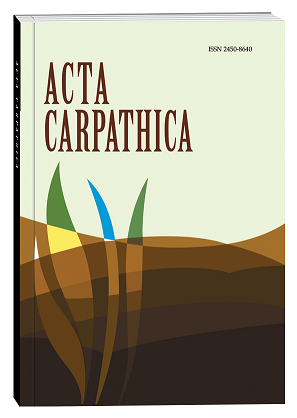RESEARCHES OF PHYSICO-CHEMICAL INDICATORS OF NATURAL WATER SOURCES OF STRIY DISTRICT
DOI:
https://doi.org/10.32782/2450-8640.2022.1.11Keywords:
underground waters, physico-chemical and organoleptic indicators, general hardness, content of chlorides, sulfates, calcium, magnesiumAbstract
For the purpose of economic activity, a person uses water resources. Despite the large volumes of fresh water, they are increasingly reduced due to a number of reasons, such as the non-rational use of water sources, their pollution. About 20% of urban residents and 75% of rural residents of the world do not meet their daily water needs. Based on the region of residence and the standard of living of its population, the volume of water consumed by one person ranges from 3 to 700 liters per day. The strong economic development of individual regions also affects the industrial use of water in these regions. The largest amount of water is consumed by: agriculture, and especially if it is located in dry climatic conditions, where quite a large amount of water is used for irrigation, as well as metallurgical, chemical, food, petrochemical, pulp and paper industries. An increase or decrease in water consumption depends proportionally on the development or decline of certain branches of industry or agriculture. A document entitled "Water Strategy of Ukraine for the period until 2025" has been developed and is in force in our country. This document analyzes and defines the main problems of Ukraine, such as the lack of a sufficient supply of water resources, their uneven distribution by territory and time; depletion or depletion of water resources. Тhe рrimary source of drinking water supply for the population of our region is groundwater (more than 90% of the water supply of settlements is from underground sources and about 10% – from surface). Without exaggeration, one can argue the strategic importance in the livelihood of human existence, namely groundwater. They remain the most reliable source of water supply for the population. Therefore, the study of physicochemical and organoleptic indicators of the quality of natural water sources is an extremely relevant topic. In the master’s thesis physical and chemical indices of natural water sources of Striy district are studied in accordance with the requirements of the State Sanitary Norms and Rules "Hygienic Requirements for Drinking Water intended for human consumption." (DSanPin2.2.4-171-10).
References
Білявський Г.О., Фурдуй Р.С., Костіков І.Ю., Основи екологічних знань. Київ: Либідь, 2000. 357с.
Водна стратегія України на період до 2025 року (наукові основи). Київ, 2015. 46 с.
Державні санітарні норми та правила (ДСанПін2.2.4-171-10). Гігієнічні вимоги води питної, призначеної для споживання людиною. Київ, 2010, 36 с.
ДСТУ 7525: 2014. Вода питна. Вимоги та методи контролювання якості. Київ, 2014, 65 с.
Джигирей В.С. Екологія та охорона навколишнього середовища. Київ: Знання, 2000. 357 с.
Клименко М.О., Прищепа А.М., Вознюк Н. М. Моніторинг довкілля: підручник. Київ : Академія, 2006. 360 с.
Лялюк О.Г. Моніторинг довкілля : навчальний посібник. Вінниця : ВНТУ, 2004, 140 с.
Підземні води. Підземні водні об'єкти. Словник – довідник з екології : навч.-метод. посіб. / уклад. О. Г. Лановенко, О. О. Остапішина. Херсон : ПП Вишемирський В.С., 2013. 138 с.
Природні ресурси Львівщини: атлас. / За ред. Матолич Б. М., Ковальчук І. П. Львів: ПП Лукащук В. С., 2009. 120 с.
Прийма А.М. Основи хімічної технології. Навчальний посібник. Дрогобич: Редакційно-видавничий відділ Дрогобицького державного педагогічного університету імені Івана Франка, 2012. 314 с.








